At The Hatchery Butterfly Farm, we strive to merge education, conservation, and craftsmanship, embodying the principles of ethical taxidermy. By working with butterflies, which are vital components of ecosystems and cherished cultural symbols, we aim to educate and inspire through sustainable practices.
Butterflies and Their Role in the Ecosystem
Butterflies are integral to the food chain, serving as a primary food source for a diverse array of predators, including ants, spiders, flies, wasps, birds, lizards, mice and more. I’ve even seen stray cats pounce and chow down on a butterfly or two. Despite not being at the "base" of the food chain, butterflies at all life stages are indispensable in maintaining ecological balance. As Jim McCormac eloquently put it, “Caterpillars represent the vast underworld of the food chain... they make the natural world go ’round.”1
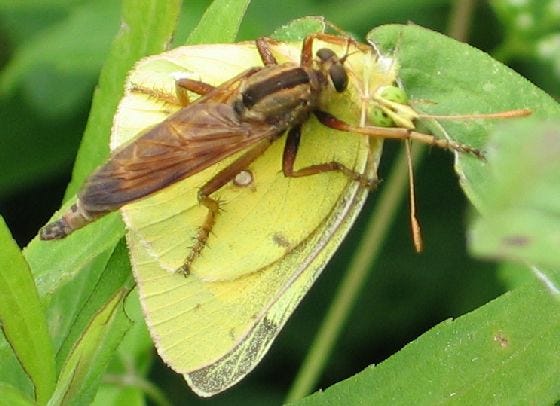


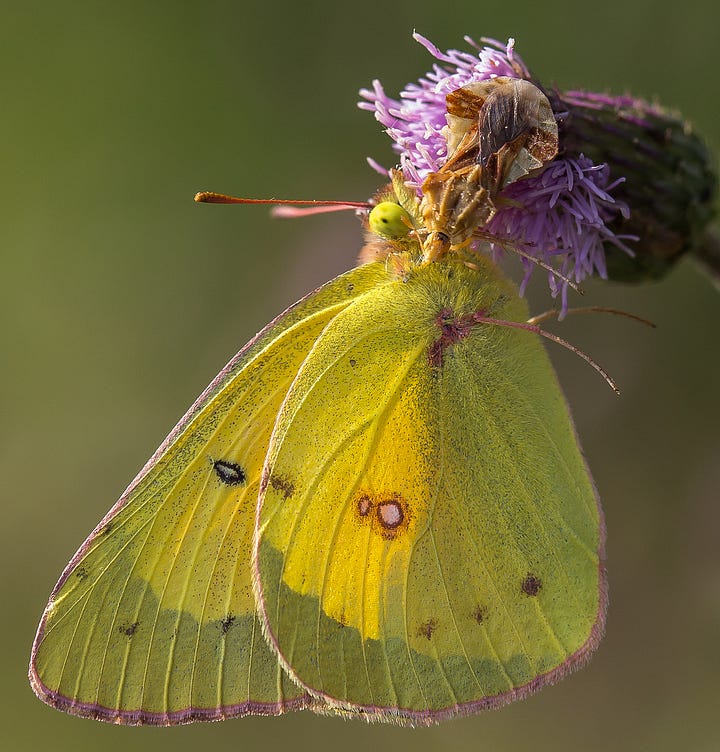
To survive predation, butterflies have evolved several strategies which include laying an abundance of eggs. Depending on the species, a single female can lay anywhere from 100 to 1,000 eggs, with only 2-5% reaching adulthood in the wild. Even species known for their toxicity, like monarchs, are not immune to predation, as their toxicity is dependent on the type of milkweed consumed during their larval stage. Brad Guhr of the Dyck Arboretum located in Hesston, KS in his article on Monarch butterflies elaborates:
“The individual toxicity depends a lot on the particular milkweed species that hosted the larval stage. Asclepias syriaca (common milkweed) and Cynanchum laeve (honeyvine milkweed) are not nearly as toxic as A. verticillata (whorled milkweed) […] Turns out that only 25-40% of the population being toxic confers protection for the remaining population.”2
Taking into consideration that fewer wild butterflies make it to adulthood due to early life-stage predation, the likelihood of someone finding a nearly perfect wild specimen that died from natural causes is low. Entomologists in the field typically catch insects using various methods like nets, traps, or by hand, and then kill them using a "killing jar" which contains a chemical vapor that quickly euthanizes the insects with minimal damage to the specimen, allowing them to be properly preserved for study. However in captivity, with higher rates of butterfly survival into adulthood, the likelihood of finding good quality specimens that died from natural causes — both biotic and abiotic — increases. When butterfly taxidermy is not used primarily for scientific study, the ethical sourcing of butterflies becomes a genuine source of concern.
Note — Greg R. Pohl, 2012 President of the Alberta Lepidopterists’ Guild wrote a phenomenal piece that details the importance and ethics of collecting limited numbers of wild specimens for scientific study: “Because we know little or nothing about most insect species, and they are very difficult to identify, it is necessary to kill and collect them to study them. Collecting insects is a vital part of most entomology research, including taxonomic, diagnostic, biodiversity, and pest management work.”3
Ethical Sourcing in Practice
Our work at The Hatchery focuses on breeding captive butterflies for educational exhibits, supporting pollinator conservation and public awareness. Each year, we supply thousands of butterflies to exhibits across the U.S., contributing to critical education about pollinators and their habitats. Any taxidermied butterflies we may offer for sale are deemed “ethically sourced” because they are not taken from wild populations — but we take our ethics one step further.
Predation is the primary cause of butterfly mortality, both in wild populations and in captivity. Within our flight house, we manage predator populations carefully but cannot completely eliminate them. These predators do not discriminate between a day-old butterfly and a three-week-old butterfly, so it is not uncommon for them to leave slightly damaged or pristine specimens. It’s important to note that the butterflies we keep in the flight house are for breeding purposes. These butterflies have been tested for disease, selected to maintain genetic diversity, and have shown to be fit, strong fliers — the best of the best. When one of our butterfly breeding stock falls prey to a spider a day after it emerged, it is not something to celebrate. Yes, we now have a pristine specimen, but that’s not the point. Continuing to raise butterflies to contribute to critical education about pollinators and their habitats is our primary objective.
Ambush spiders like jumping spiders, crab spiders, and wolf spiders are the top predators in our flight house. These spiders do not create webs and take a much more active approach to catching their prey. Butterflies caught by ambush predators are often found in pristine condition. These specimens are then collected and preserved.
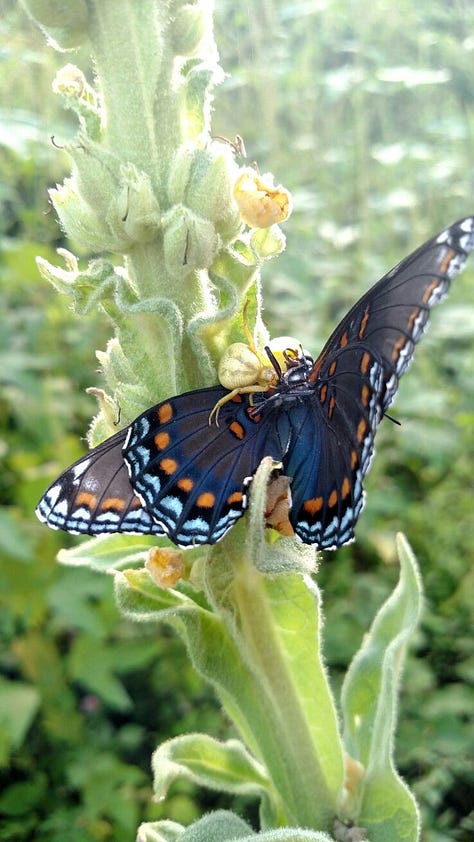
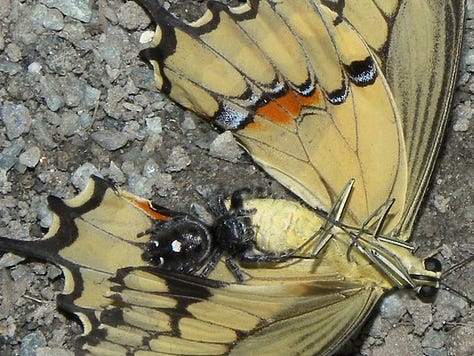
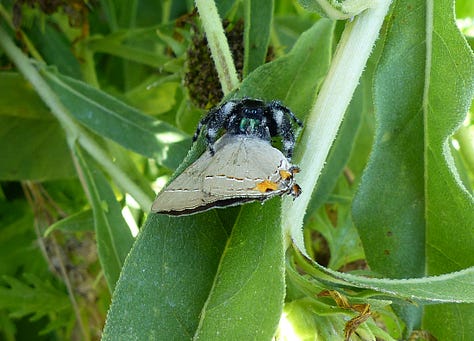


The second most common group of predators in the flight house are webbing spiders (and in particular, black widows — eek!) Butterflies get caught in webbing and as a result only one or two wings are usually salvageable. These wings are collected and preserved to extend the butterfly’s legacy as a symbol of transformation, beauty, and the intricate balance of life.
The third most common predator in the flight house is the praying mantis. Praying mantises may enter the flight house at a young age and go unnoticed in foliage, preying upon smaller insects like flies. Only when they are larger do we discover their presence. Praying mantises eat the main body of the butterfly and often leave behind a of pile of perfect wings. These wings are collected and used in our Butterfly Wings of Kansas frames and our Butterfly Wing Charms.


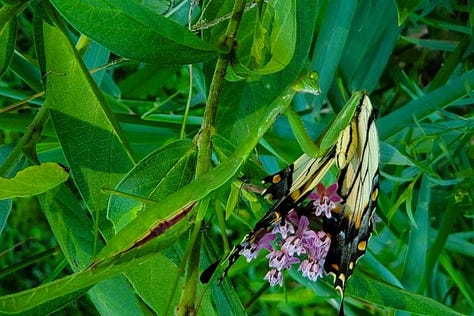
The last main way our butterflies the in the flight house pass on is from old age. These specimens will certainly have damaged wings. Once these butterflies pass, the wings are collected, and sections that are still in good condition will be used in our butterfly wing jewelry. This ensures that all of our butterfly wing jewelry has been made with the highest ethical standards in mind.
One major aspect of ethical breeding is the awareness of the signs and symptoms of butterfly disease and genetic bottleneck — it is our job to keep maladaptive traits from entering wild populations. Any butterflies that show abnormalities or signs of disease in the larval or pupal phase are isolated and monitored, and often euthanization is ethically-justified. Examples include a butterfly with a split proboscis, a monarch testing positive for the presence of Oe, or a malformed chrysalis showing maladaptive recessive traits. These ethically euthanized butterflies and wings make up a very small portion of our framed specimens and wings collection.
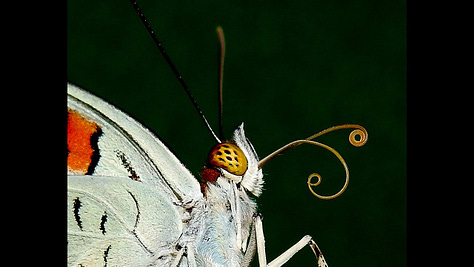


A Philosophy of Respect and Stewardship
Ethical taxidermy emphasizes sustainability and conservation. Unlike traditional taxidermy, which may involve hunting or unsustainable practices, our approach ensures that no wild populations are impacted. Many places claim their butterflies are ethically sourced, but it is often difficult to verify those claims. That is why our butterflies are ethically sourced from us.
By adhering to the ideals of ethical taxidermy, we highlight the beauty of butterflies while educating the public about their ecological significance. Framed specimens, jewelry, and other creations are tools to foster appreciation and awareness, not merely decorative objects.
Ecological Restoration in Action
Our practices extend beyond taxidermy. In urban Wichita, KS, we’ve transformed our landscaping into an oasis of native and ecologically-supportive plants. This effort has revitalized local butterfly populations, demonstrating the power of habitat restoration even in developed areas. By promoting the inclusion of native and ecologically supportive plants in home gardens, we encourage others to take part in conservation, one yard at a time.
Closing Thoughts
Butterflies symbolize transformation, beauty, and the intricate balance of life. Through ethical taxidermy, we honor these creatures and their vital roles in our world. Whether it’s by preserving a single wing in a charm or framing a pristine specimen, every piece tells a story of nature’s resilience and our responsibility to protect it.
Together, let’s create a future where butterflies continue to thrive, inspiring generations to come.
Jim McCormac, For The Columbus Dispatch. “Nature: Seldom-Seen Caterpillars Vital Link in Food Chain.” The Columbus Dispatch, The Columbus Dispatch, 16 Sept. 2018, www.dispatch.com/story/lifestyle/home-garden/2018/09/16/nature-seldom-seen-caterpillars-vital/10287005007/.
Guhr, Brad. “Monarch Fallout and a Predator Story - Dyck Arboretum %.” Dyck Arboretum, 9 Nov. 2020, dyckarboretum.org/monarch-fallout/.
Pohl , Greg. “In Defense of Collecting.” LepLog, LepLog: butterfly and moth observation | research | conservation, 4 Dec. 2012, leplog.wordpress.com/2012/12/03/in-defense-of-collecting/#:~:text=Because%20we%20know%20little%20or,biodiversity%2C%20and%20pest%20management%20work.



